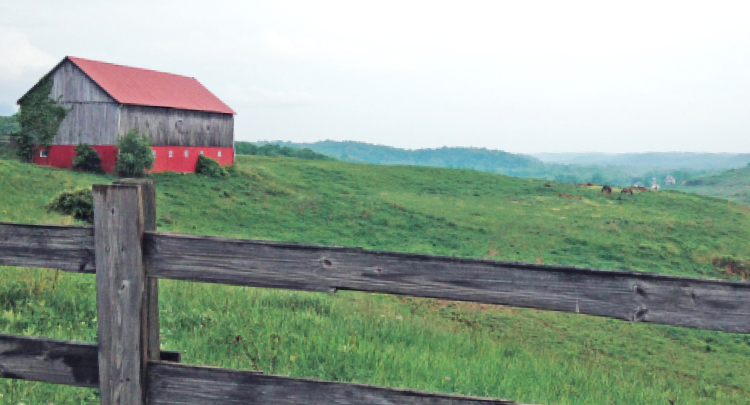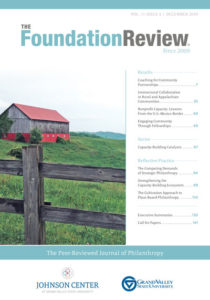Building Capacity and Engaging With Communities


 Issues of The Foundation Review are either themed or unthemed collections. But, as sometimes happens with unthemed issues, we serendipitously ended up with several articles on a common theme in Volume 11, Issue 4 — in this case, capacity building. These articles confirm that while there is no one right way to build capacity, there are some general principles that connect our work.
Issues of The Foundation Review are either themed or unthemed collections. But, as sometimes happens with unthemed issues, we serendipitously ended up with several articles on a common theme in Volume 11, Issue 4 — in this case, capacity building. These articles confirm that while there is no one right way to build capacity, there are some general principles that connect our work.
One of the guiding beliefs behind the existence of this journal is that the oft-repeated statement, “When you’ve seen one foundation, you’ve seen one foundation” is not true. There is complexity inherent in the variety of foundation types at work today, and the issues they are addressing. Yet there is much we can learn from each other about how to best match what foundations can offer with the needs of grantee organizations, communities, and contexts. The articles in this issue exemplify that kind of learning.
The three articles that do not focus on capacity building address how funders engage with communities. Their insights are broadly applicable for foundations doing many kinds of work. I invite you to explore this issue of the The Foundation Review, outlined below.
In this article, the authors describe the results and implications of their evaluation of a coaching program for multisectoral community partnerships aimed at addressing health and health inequities. Kim, Schottenfeld, and Cavanaugh found that the coaching did strengthen some partnerships’ capacity, especially their ability to engage in systems change and advocacy. However, they also note that these partnerships are often led by professionals without lived experiences of inequity, and coaching around inclusion may be less effective than funding partnerships that already prioritize more grassroots leadership.
The Ohio Department of Mental Health and Addiction Services found that many nonprofits lack capacity to collect and use data, preventing them from competing effectively for federally funded prevention services. The department partnered with two nonprofit organizations and a university to create an investment strategy that provided monetary awards to community organizations and included intensive, customized training and technical assistance. Milazzo, Raffle, and Courser identified the multi-year, tiered support and peer learning as two of the keys to successful capacity building.
In this article, the authors discuss the Methodist Healthcare Ministries of South Texas experiences in funding capacity building. The organization created a $1.5 million capacity-building program for groups doing front-line work at the U.S. — Mexico border. They suggest that funders need to consider their own role (when to step in and when to step back), how to sustain the results of capacity building, and how to use evaluation to facilitate learning.
Community foundations have the potential to promote collaborative learning in a variety of ways as conveners, funders, and, in some instances, as nonprofit capacity builders. Bingle focuses on nonprofit capacity building by Illinois community foundations. He categorizes these efforts as transformational or transactional, noting that different circumstances call for one or the other. Foundations identified lack of time as the biggest barrier to capacity building.
Altman Smith and Taylor note that nonprofits often find it challenging to find providers best suited to meet their capacity-building needs; this is especially true when looking to strengthen racial equity capacity. The Kresge Foundation’s Fostering Urban Equitable Leadership program had sought to build both the capacity of grantees and the capacity of providers of capacity development. Among other benefits, bringing capacity builders together enabled greater collaboration and helped them identify opportunities to either expand their offerings or refer stakeholders to other service providers.
Baker and Constantine describe how a fellowship program supported the Richmond Memorial Health Foundation’s transformation from a health legacy foundation focused on access to health care, to one promoting regional health equity through a racial and ethnic identity lens. The trustees decided to invite community members to inform and advance the health equity strategy through two distinct community fellowship programs — the Equity + Health Fellowships. This article highlights the outcomes of both programs. The experience enhanced the foundation’s impact and learning, and enabled the foundation to identify areas that require strengthening as its transformation continues.
In this article, the authors explore the need to balance foundations’ internal agenda-setting, intellectual frameworks, and methods with engaging competing voices from the field. The William Penn Foundation has endeavored to achieve this balance in its support for watershed protection and restoration. Based on an evaluation conducted during the first four years of the initiative, the article examines four interrelated tensions and how each of these tensions has played out as the initiative has evolved.
Easterling, Gesell, McDuffee, Davis, and Patel describe cultivation as a decentralized approach to place-based philanthropy. Cultivation presumes that the seeds of high-payoff solutions are already circulating somewhere in the community. This article describes the cultivation approaches taken by the Clinton Foundation, Kate B. Reynolds Charitable Trust, and The Colorado Health Foundation, and presents findings from an evaluation of the Clinton Foundation’s Community Health Transformation model. It also introduces a taxonomy of the six roles foundations play in place-based philanthropy, which is useful in clarifying the intent of place-based foundations.
Not yet a subscriber? Click here to start your free 90-day trial.